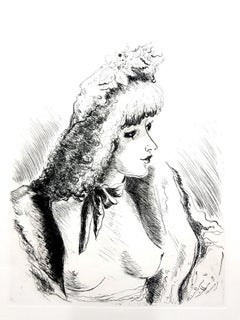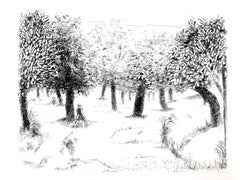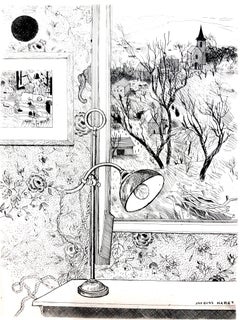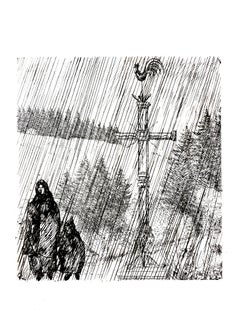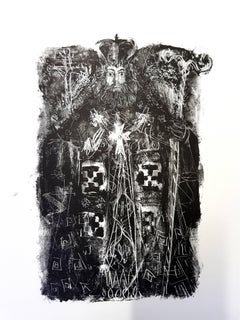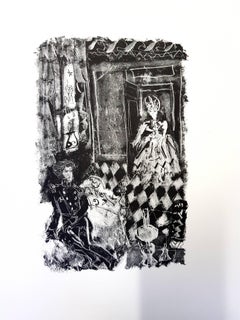1940s Portrait Prints
19
to
33
152
100
47
17
220
32
118
79
34
8
13
Overall Height
to
Overall Width
to
130
20
7
3
2
2
1
182
101
94
78
76
44
34
33
32
27
25
19
17
13
11
7
6
6
6
5
369
1,384
4,257
2,562
52
94
163
149
252
258
448
843
680
348
303
22
15
13
12
10
114
70
39
20
13
Period: 1940s
André Dignimont - Belle Epoque Portrait - Original Etching
Located in Collonge Bellerive, Geneve, CH
André Dignimont - Belle Epoque Portrait - Original Etching
Paris, Le Gerbier, 1946
Edition of 340
André Dignimont was born in Paris. He studied at the...
Category
Modern 1940s Portrait Prints
Materials
Etching
Robert Lotiron - Landscape - Original Etching
Located in Collonge Bellerive, Geneve, CH
Robert Lotiron - Landscape - Original Etching
Paris, Le Gerbier, 1946
Edition of 340
Born 29 October 1886, in Paris; died 18 April 1966, in Rueil-Malmaison.
Painter (gouache), watercolourist, draughtsman, engraver, lithographer, illustrator. Landscapes. Murals, designs for tapestries.
Robert Lotiron was a pupil of Jules Lefebvre...
Category
Modern 1940s Portrait Prints
Materials
Etching
Jacques Maret - Dreamy Desk - Original Etching
Located in Collonge Bellerive, Geneve, CH
Jacques Maret - Dreamy Desk - Original Etching
Paris, Le Gerbier, 1946
Edition of 340
Jacques Maret was a French visual artist who was born in 1900. Several works by the artist have...
Category
Modern 1940s Portrait Prints
Materials
Etching
Jean Émile Laboureur - Under the Cross - Original Etching
Located in Collonge Bellerive, Geneve, CH
Jean Émile Laboureur - Under the Cross - Original Etching
Paris, Le Gerbier, 1946
Edition of 340
JEAN-ÉMILE LABOUREUR
Founder in 1923 of the Soci...
Category
Modern 1940s Portrait Prints
Materials
Etching
Antoni Clavé - Original Lithograph - For Pushkin's Queen of Spades
By Antoni Clavé
Located in Collonge Bellerive, Geneve, CH
Antoni Clavé - Original Lithograph - For Alexander Pushkin's Queen of Spades
Dimensions: 325 x 247 mm.
1946
Original lithograph of Antoni Clavé
Edit...
Category
Modern 1940s Portrait Prints
Materials
Lithograph
Antoni Clavé - Original Lithograph - For Pushkin's Queen of Spades
By Antoni Clavé
Located in Collonge Bellerive, Geneve, CH
Antoni Clavé - Original Lithograph - For Alexander Pushkin's Queen of Spades
Dimensions: 325 x 247 mm.
1946
Original lithograph of Antoni Clavé
Edition: 300
The Queen of Spades. Tr...
Category
Modern 1940s Portrait Prints
Materials
Lithograph
Raoul Dufy - Adam and Eve in Modernity - Original Etching
By Raoul Dufy
Located in Collonge Bellerive, Geneve, CH
Raoul Dufy - Haussmann Architecture - Original Etching
Dimensions: 13 x 10".
Edition of 200
1940
Edition Les Bibliophiles du Palais, Paris
Raoul Dufy
Born in 1877, the French painte...
Category
Modern 1940s Portrait Prints
Materials
Etching
Antoni Clavé - Original Lithograph - For Pushkin's Queen of Spades
By Antoni Clavé
Located in Collonge Bellerive, Geneve, CH
Antoni Clavé - Original Lithograph - For Alexander Pushkin's Queen of Spades
Dimensions: 325 x 247 mm.
1946
Original lithograph of Antoni Clavé
Edition: 300
The Queen of Spades. Tr...
Category
Modern 1940s Portrait Prints
Materials
Lithograph
Raoul Dufy (after) - Lithograph
Located in Collonge Bellerive, Geneve, CH
(after) Raoul Dufy
Lithograph after a watercolor, published in the book "Lettre à mon peintre Raoul Dufy." Paris, Librairie Académique Perrin, 1965.
Printed signature
Di...
Category
Fauvist 1940s Portrait Prints
Materials
Lithograph
Autoportrait - Lithograph
Located in Collonge Bellerive, Geneve, CH
(after) Raoul Dufy
Lithograph after a watercolor, published in the book "Lettre à mon peintre Raoul Dufy." Paris, Librairie Académique Perrin, 1965.
Printed signature
Di...
Category
Fauvist 1940s Portrait Prints
Materials
Lithograph
Surrealist Composition with Bird in Profile
Located in Fairlawn, OH
Engraving, aquatint and mixed intaglio
Signed, dated and annotated "AP"
References And Exhibitions:
Tschacbasov was a Russian/Amiercan artist who was widely exhibited and collecte...
Category
Surrealist 1940s Portrait Prints
Materials
Aquatint, Engraving, Intaglio
Foxhound
By Diana Thorne
Located in Florham Park, NJ
Diana Thorne’s Dogs: An Album of Drawings.
Diana Thorne.
Julian Messner, Inc.
New York, 1944.
24 Drawings in Lithography.
“In drawing them,” she writes, “I have tried to ma...
Category
American Realist 1940s Portrait Prints
Materials
Lithograph
Paglieri dai Fiori le Cipri I Profumi
Located in Spokane, WA
Original vintage poster: Paglieri dai fiori le Cipri i Profumi. Italian artist: Gino Boccasile (1901 - 1952). Size: 13.25" x 19". Archival linen backed authentic Italian post...
Category
American Realist 1940s Portrait Prints
Materials
Offset
Fillette
Located in London, GB
Lithograph on vellum paper, Edition of 25
Paper size: 33 x 26.5 cms (13 x 10 1/2 ins)
Image size: 31.5 x 21.2 cms (12 3/8 x 8 3/8 ins)
Category
Impressionist 1940s Portrait Prints
Materials
Lithograph
1945 Mexican Modernist Silkscreen Serigraph Print Regional Folk Art Dress Mexico
Located in Surfside, FL
This listing is for the one Silkscreen serigraph piece listed here.
Mexico City, 1945. First edition. plate signed, limited edition of 1000, these serigraph plates depict various types of traditional and folk art indigenous clothing and costume styles from around Mexico. The illustrations depict the cultures of many different states in Mexico, including Oaxaca, Chiapas, Jalisco and Veracruz.
Carlos Mérida (December 2, 1891 – December 21, 1985) was a Guatemalan artist who was one of the first to fuse European modern painting to Latin American themes, especially those related to Guatemala and Mexico. He was part of the Mexican muralism movement in subject matter but less so in style, favoring a non-figurative and later geometric style rather than a figurative, narrative style. Mérida is best known for canvas and mural work, the latter including elements such as glass and ceramic mosaic on major constructions in the 1950s and 1960s. One of his major works, on the Benito Juarez housing complex, was completely destroyed with the 1985 Mexico City earthquake, but a monument to it exists at another complex in the south of the city.
Carlos Mérida was born Carlos Santiago Ortega in Guatemala City to Serapio Santiago Mérida and Guadalupe Ortega Barnoya. He later changed his name what is known by as he thought it was more sonorous. His brothers and children also took the Mérida name later on. He was of mixed Spanish/Maya-Quiché heritage which he promoted during his life.
As a young child, Mérida had both music and art lessons, and his first passion was music, which led to piano lessons. He studied at a trade school called the Instituto de Artes y Oficios, then the Instituto de Ciencias y Letras. Here he began to have a reputation for the avant garde.
Merída’s first trip to the United States was in 1917, where he met writer Juan José Tablada. Mérida made several trips to Europe over his lifetime to both study art and work as an artist and diplomat. His early trips in the 1920s and 1930s put him in touch with both avant garde movements in Europe as well as noted Latin American artists, especially those from Mexico. His last trip was in 1950s.
In 1963, he donated canvases, graphic pieces and mural sketches to the Universidad Nacional Autónoma de Mexico. Merida was one of a number of artists such as Diego Rivera and Gerardo Murillo who became committed to promoting the handcrafts and folk art of Mexico and Central America, with a particular interest in those of Guatemala, often featuring Mayan textiles or elements in their decoration in his artwork. He died in Mexico City at the age of 94 on December 21, 1985.
As there was little opportunity for artists in Guatemala, in 1910, Mérida traveled to Paris with a friend named Carlos Valenti on a German cargo ship. From then until 1914, he lived and worked in Paris and traveled much of Europe. This put him in touch with European avant garde artists such as Van Dagen, Amedeo Modigliani, Pablo Picasso and Piet Mondrian as well as Latin American artists studying in Europe such as Diego Rivera, Jorge Enciso, Ángel Zárraga and Dr. Atl. He exhibited his work in venues such as the Independent Salon and the Giroux Gallery in Paris.
Mérida has forty five exhibitions in the United States and eighteen in Mexico from 1928 to 1948. These included an exhibition with Rufino Tamayo at the Art Center of New York (1930), the John Becker and Valentine galleries in New York (1930), the Club de Escritores de México and the Galería Posada in Mexico City (1931), the Stendhal Gallery and the Stanley Rose...
Category
Folk Art 1940s Portrait Prints
Materials
Screen
1945 Mexican Modernist Silkscreen Serigraph Print Regional Folk Art Dress Mexico
Located in Surfside, FL
This listing is for the one Silkscreen serigraph piece listed here.
Mexico City, 1945. First edition. plate signed, limited edition of 1000, these serigraph plates depict various types of traditional and folk art indigenous clothing and costume styles from around Mexico. The illustrations depict the cultures of many different states in Mexico, including Oaxaca, Chiapas, Jalisco and Veracruz.
Carlos Mérida (December 2, 1891 – December 21, 1985) was a Guatemalan artist who was one of the first to fuse European modern painting to Latin American themes, especially those related to Guatemala and Mexico. He was part of the Mexican muralism movement in subject matter but less so in style, favoring a non-figurative and later geometric style rather than a figurative, narrative style. Mérida is best known for canvas and mural work, the latter including elements such as glass and ceramic mosaic on major constructions in the 1950s and 1960s. One of his major works, on the Benito Juarez housing complex, was completely destroyed with the 1985 Mexico City earthquake, but a monument to it exists at another complex in the south of the city.
Carlos Mérida was born Carlos Santiago Ortega in Guatemala City to Serapio Santiago Mérida and Guadalupe Ortega Barnoya. He later changed his name what is known by as he thought it was more sonorous. His brothers and children also took the Mérida name later on. He was of mixed Spanish/Maya-Quiché heritage which he promoted during his life.
As a young child, Mérida had both music and art lessons, and his first passion was music, which led to piano lessons. He studied at a trade school called the Instituto de Artes y Oficios, then the Instituto de Ciencias y Letras. Here he began to have a reputation for the avant garde.
Merída’s first trip to the United States was in 1917, where he met writer Juan José Tablada. Mérida made several trips to Europe over his lifetime to both study art and work as an artist and diplomat. His early trips in the 1920s and 1930s put him in touch with both avant garde movements in Europe as well as noted Latin American artists, especially those from Mexico. His last trip was in 1950s.
In 1963, he donated canvases, graphic pieces and mural sketches to the Universidad Nacional Autónoma de Mexico. Merida was one of a number of artists such as Diego Rivera and Gerardo Murillo who became committed to promoting the handcrafts and folk art of Mexico and Central America, with a particular interest in those of Guatemala, often featuring Mayan textiles or elements in their decoration in his artwork. He died in Mexico City at the age of 94 on December 21, 1985.
As there was little opportunity for artists in Guatemala, in 1910, Mérida traveled to Paris with a friend named Carlos Valenti on a German cargo ship. From then until 1914, he lived and worked in Paris and traveled much of Europe. This put him in touch with European avant garde artists such as Van Dagen, Amedeo Modigliani, Pablo Picasso and Piet Mondrian as well as Latin American artists studying in Europe such as Diego Rivera, Jorge Enciso, Ángel Zárraga and Dr. Atl. He exhibited his work in venues such as the Independent Salon and the Giroux Gallery in Paris.
Mérida has forty five exhibitions in the United States and eighteen in Mexico from 1928 to 1948. These included an exhibition with Rufino Tamayo at the Art Center of New York (1930), the John Becker and Valentine galleries in New York (1930), the Club de Escritores de México and the Galería Posada in Mexico City (1931), the Stendhal Gallery and the Stanley Rose...
Category
Folk Art 1940s Portrait Prints
Materials
Screen
1945 Mexican Modernist Silkscreen Serigraph Print Regional Folk Art Dress Mexico
Located in Surfside, FL
This listing is for the one Silkscreen serigraph piece listed here.
Mexico City, 1945. First edition. plate signed, limited edition of 1000, these serigraph plates depict various types of traditional and folk art indigenous clothing and costume styles from around Mexico. The illustrations depict the cultures of many different states in Mexico, including Oaxaca, Chiapas, Jalisco and Veracruz.
Carlos Mérida (December 2, 1891 – December 21, 1985) was a Guatemalan artist who was one of the first to fuse European modern painting to Latin American themes, especially those related to Guatemala and Mexico. He was part of the Mexican muralism movement in subject matter but less so in style, favoring a non-figurative and later geometric style rather than a figurative, narrative style. Mérida is best known for canvas and mural work, the latter including elements such as glass and ceramic mosaic on major constructions in the 1950s and 1960s. One of his major works, on the Benito Juarez housing complex, was completely destroyed with the 1985 Mexico City earthquake, but a monument to it exists at another complex in the south of the city.
Carlos Mérida was born Carlos Santiago Ortega in Guatemala City to Serapio Santiago Mérida and Guadalupe Ortega Barnoya. He later changed his name what is known by as he thought it was more sonorous. His brothers and children also took the Mérida name later on. He was of mixed Spanish/Maya-Quiché heritage which he promoted during his life.
As a young child, Mérida had both music and art lessons, and his first passion was music, which led to piano lessons. He studied at a trade school called the Instituto de Artes y Oficios, then the Instituto de Ciencias y Letras. Here he began to have a reputation for the avant garde.
Merída’s first trip to the United States was in 1917, where he met writer Juan José Tablada. Mérida made several trips to Europe over his lifetime to both study art and work as an artist and diplomat. His early trips in the 1920s and 1930s put him in touch with both avant garde movements in Europe as well as noted Latin American artists, especially those from Mexico. His last trip was in 1950s.
In 1963, he donated canvases, graphic pieces and mural sketches to the Universidad Nacional Autónoma de Mexico. Merida was one of a number of artists such as Diego Rivera and Gerardo Murillo who became committed to promoting the handcrafts and folk art of Mexico and Central America, with a particular interest in those of Guatemala, often featuring Mayan textiles or elements in their decoration in his artwork. He died in Mexico City at the age of 94 on December 21, 1985.
As there was little opportunity for artists in Guatemala, in 1910, Mérida traveled to Paris with a friend named Carlos Valenti on a German cargo ship. From then until 1914, he lived and worked in Paris and traveled much of Europe. This put him in touch with European avant garde artists such as Van Dagen, Amedeo Modigliani, Pablo Picasso and Piet Mondrian as well as Latin American artists studying in Europe such as Diego Rivera, Jorge Enciso, Ángel Zárraga and Dr. Atl. He exhibited his work in venues such as the Independent Salon and the Giroux Gallery in Paris.
Mérida has forty five exhibitions in the United States and eighteen in Mexico from 1928 to 1948. These included an exhibition with Rufino Tamayo at the Art Center of New York (1930), the John Becker and Valentine galleries in New York (1930), the Club de Escritores de México and the Galería Posada in Mexico City (1931), the Stendhal Gallery and the Stanley Rose...
Category
Folk Art 1940s Portrait Prints
Materials
Screen
Relaxing Woman - Lithograph, 1943
Located in Paris, FR
Henri MATISSE (After)
Relaxing Woman
Lithograph after a drawing
Signature and date printed in the plate
On vellum 24.5 x 32.5 cm (c. 9.4 x 12.6 inch)
INFORMATION : This lithograph...
Category
Modern 1940s Portrait Prints
Materials
Lithograph
On the Sofa : Waiting for the Lover - Lithograph, 1943
Located in Paris, FR
Henri MATISSE (After)
On the Sofa : Waiting for the Lover
Lithograph after a drawing
Signature and date printed in the plate
On vellum 24.5 x 32.5 cm (c. 9.4 x 12.6 inch)
INFORMA...
Category
Modern 1940s Portrait Prints
Materials
Lithograph
Dreaming Woman with a Floral Shirt - Lithograph, 1943
Located in Paris, FR
Henri MATISSE (After)
Dreaming Woman with a Floral Shirt
Lithograph after a drawing
Signature and date printed in the plate
On vellum 32.5 x 24.5 cm (c. 12.6 x 9.4 inch)
INFORMATI...
Category
Modern 1940s Portrait Prints
Materials
Lithograph
